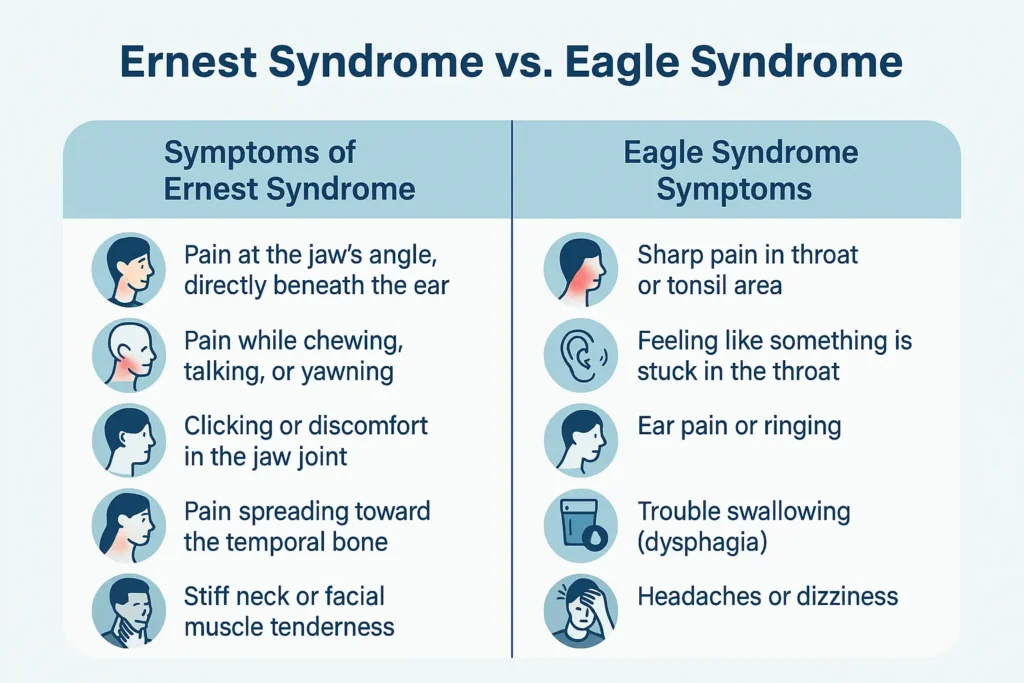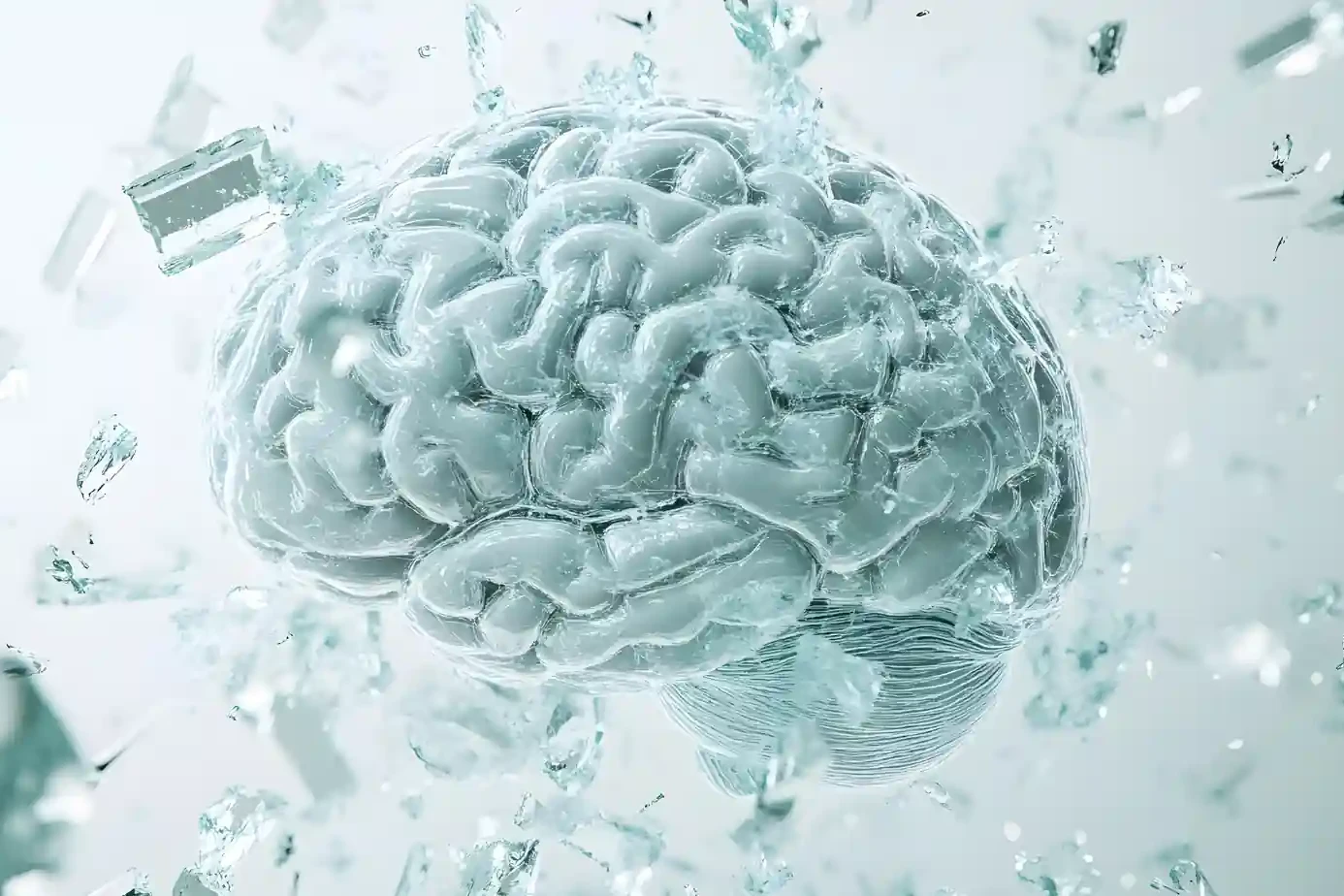Eagle syndrome and Ernest Syndrome are two rare but painful conditions that affect the head and neck. Though their symptoms often overlap, they involve different structures. Their root causes and treatments vary in many aspects.
In this blog, you’ll learn what they are, what signs to watch for, and how doctors figure out which one you have. Let’s clear up the confusion around Ernest Syndrome vs. Eagle Syndrome once and for all.
Table of Contents
ToggleWhat is Ernest Syndrome?
Ernest Syndrome is a painful disorder brought on by inflammation or damage to the stylomandibular ligament. This ligament connects the jaw joint to the base of the skull. When it’s irritated, due to trauma, clenching, or dental work, it can cause deep facial and jaw joint pain.
This condition was first characterized by Dr. Ernest, which is the reason for its name, and is also known as stylomandibular ligament syndrome. It’s a lesser-known cause of orofacial pain.
Symptoms of Ernest Syndrome
Here are some common Ernest syndrome symptoms you shouldn’t ignore:
- Pain at the jaw’s angle, directly beneath the ear
- Pain while chewing, talking, or yawning
- Clicking or discomfort in the jaw joint
- Pain spreading toward the temporal bone
- Stiff neck or facial muscle tenderness
Because it affects areas close to the cranial nerves, the pain can mimic TMJ-related pain or even toothaches.
Ernest Syndrome Causes
The main causes of Ernest Syndrome include:
- Whiplash injuries
- Dental surgeries
- Prolonged jaw clenching or grinding
- Sports injuries or trauma to the jaw
The stylomandibular ligament may be torn or stretched in several situations, resulting in inflammation and persistent pain.
Complications of Ernest Syndrome
If left untreated, Ernest Syndrome can lead to:
- Persistent craniofacial pain disorders
- Trouble opening the mouth fully
- Sleep problems due to jaw pain
- Referred pain to the facial muscles and neck
Some patients even mistake it for a tooth problem or nerve issue, delaying proper diagnosis.
Ernest Syndrome Treatment
The severity of the symptoms determines Ernest syndrome treatment.
Here are some options:
- Physical therapy including gentle Ernest syndrome exercises to stretch and relax the ligament
- Anti-inflammatory medications to reduce swelling and pain
- Local anesthetic or corticosteroid injections at the pain site
- Soft diet to reduce strain on the jaw joint
- Heat or cold therapy for symptom relief
If symptoms persist despite conservative treatments, surgical release of the stylomandibular ligament may be considered in rare cases.
What is Eagle Syndrome?
Eagle syndrome is a structural disorder where the styloid process (a small bone near the skull base) becomes too long or calcified. This bony growth may irritate nearby tissues, including the glossopharyngeal nerve, blood vessels, or throat muscles.
Common causes of Eagle syndrome include an elongated styloid process, scar tissue from tonsil surgery, or natural anatomical differences.
The condition is named after Dr. Watt Eagle, who first described it in 1937.
Eagle Syndrome Symptoms
The top eagle syndrome symptoms include:
- Sharp pain in the throat or tonsil area
- Feeling like something is stuck in the throat
- Ear pain or ringing
- Pain when turning the head
- Trouble swallowing (dysphagia)
- Headaches or dizziness
- Pressure around the hyoid bone
In rare cases, if the elongated styloid process pushes on blood vessels, it can cause serious vascular issues. These symptoms mimic craniofacial pain disorders, making diagnosis tricky.
Eagle Syndrome Causes
The most common causes of Eagle syndrome include:
- Genetic bone growth (elongated styloid process)
- Aging-related changes
- Injury or trauma to the neck
- Previous neck surgeries or tonsillectomy
Some people are simply born with longer-than-normal styloid processes, which may not cause symptoms until later in life.
Eagle Syndrome Complications
When not treated, Eagle syndrome can lead to:
- Constant throat and neck pain
- Nerve compression (especially the glossopharyngeal nerve)
- Risk of stroke in extreme vascular cases
- Disrupted daily life and eating issues
Eagle Syndrome Treatment
The severity of the symptoms determines how Eagle syndrome is treated. Here’s how it is usually managed:
- Mild cases: Over-the-counter pain relievers and rest
- Injections: Numbing agents or steroids may help reduce pain associated with the styloid process.
- Surgery: In severe cases, surgeons remove part or all of the elongated styloid process to relieve pressure
The surgical method used is called a styloidectomy, which may be done through the mouth or neck. This is the most effective option when other treatments don’t help.
Key Differences: Ernest Syndrome vs Eagle Syndrome

| Feature | Ernest Syndrome | Eagle Syndrome |
| Affected Area | Stylomandibular ligament (Ligament that links the jaw to the skull) | Styloid process or stylohyoid ligament (Small bone at the skull base or nearby ligament) |
| Pain Location | Back jaw, under the ear, face side | Throat, ear, side of the neck |
| Causes | Injury, dental work, or tight jaw muscles | Extra-long bone or hard ligament, often after surgery |
| Symptoms | Jaw pain, earache, tight face muscles | Throat pain, hard to swallow, ear pressure |
| Diagnosis | Doctor checks sore spots around jaw | X-ray or CT shows long or stiff bone |
| Treatment | Exercises, pain relief, injections | Pain meds, injections, or bone surgery |
When to Seek Specialist Evaluation?
If you’ve had TMJ-related pain, jaw tightness, or throat discomfort that doesn’t go away with usual care, it’s time to consult a specialist.
Ear, Nose, and Throat (ENT) doctors or neurologists familiar with craniofacial pain disorders can help. If you’ve had dental work, whiplash, or prior neck surgery, mention it.
Imaging such as CT or MRI may be required if your doctor suspects Eagle syndrome or perform a palpation exam if Ernest Syndrome is likely. Early detection avoids unnecessary treatments.
FAQs on Ernest Syndrome vs. Eagle Syndrome
What is the difference between Ernest Syndrome and Eagle Syndrome?
Ernest Syndrome involves ligament pain in the jaw. Eagle syndrome is caused by a bone pressing on nerves or vessels in the neck and throat.
What are the common symptoms of Ernest Syndrome?
Common Ernest syndrome symptoms include jaw pain, ear ache, face soreness, pain when opening the mouth, and discomfort in the back of the jaw.
What are the symptoms of Eagle Syndrome?
Throat pain, ear pain, trouble swallowing, and pain when turning your head.
How are Ernest Syndrome and Eagle Syndrome diagnosed?
Ernest Syndrome is diagnosed through physical exams. Eagle syndrome is confirmed through imaging like X-rays or CT scans showing bone length or calcification.
Is Eagle Syndrome dangerous?
Yes. In rare cases, Eagle syndrome can compress arteries or cranial nerves, causing serious complications like dizziness, fainting, or stroke-like symptoms.
What causes Ernest Syndrome?
Injury, dental work, whiplash, or trauma to the jaw.
What causes Eagle Syndrome?
Eagle syndrome is caused by an elongated styloid process or calcified ligaments near the skull base, which irritate nearby tissues or nerves.
How is Ernest Syndrome treated?
Ernest syndrome treatment includes therapy, jaw rest, injections, and Ernest syndrome exercises. Surgery is rare and used only in severe cases.
What are the treatment options for Eagle Syndrome?
Eagle syndrome treatment available are medications, steroid injections, or surgery (styloidectomy) if pain is severe or persistent.
Can exercises help with Ernest Syndrome and Eagle Syndrome?
Ernest syndrome exercises may help. Eagle usually needs surgery if severe.
What kind of doctor treats Ernest Syndrome and Eagle Syndrome?
Both conditions can be treated by ENTs, oral surgeons, neurologists, or pain specialists with knowledge of orofacial pain.
Are Ernest Syndrome and Eagle Syndrome related?
They’re similar in symptoms but not causes. Ernest Syndrome is ligament-related. Eagle syndrome involves a bone structure issue.
Can Ernest Syndrome and Eagle Syndrome cause dizziness or headaches?
Yes. Both conditions can affect cranial nerves, which may cause dizziness, headaches, or nerve-related facial pain.
Is surgery the only option for Eagle Syndrome?
No. While surgery is the most effective Eagle syndrome treatment, some patients find relief with medications or injections.
About The Author

This article is medically reviewed by Dr. Chandril Chugh, Board-Certified Neurologist, providing expert insights and reliable health information.
Dr. Chandril Chugh is a U.S.-trained neurologist with over a decade of experience. Known for his compassionate care, he specializes in treating neurological conditions such as migraines, epilepsy, and Parkinson’s disease. Dr. Chugh is highly regarded for his patient-centered approach and dedication to providing personalized care.
→ Book a consultation to discover which remedies suit your needs best.




